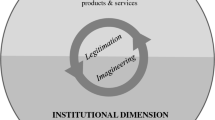Abstract
This article investigates the promising, new subject matter of Islamic branding, which is yet to receive the academic attention it deserves. It provides a better understanding of Islamic branding, through conceptualizing the terms relevant to the brand-Islamization efforts of non-Muslim brands, by identifying the necessary ‘branding to Muslims’ practices. It differentiates between Islamic products and Islamic brands, identifies and explains the various types of Islamic branding and links them to the Islamization of originally non-Muslim brands, that is, international brands, and it discusses various halal-related issues that an Islamizing firm needs to adhere to in order to improve its chances of success in the Islamic market. Existing information sources at both academic and business levels reveal that knowledge remains scarce in this field. Therefore, the identification and conceptualization of the various Islamic branding terms offers ample opportunities for researchers to investigate. Researchers investigating the concept and practice of Islamic branding currently are drawing the inaugural road map for future research, and thus determining its long-term direction.
Similar content being viewed by others
References
Adelman, J. (1994) Post-populist Argentina. New Left Review 203: 26.
Amsden, A.H. (1989) Asia's Next Giant: South Korea and Late Industrialization. New York: Oxford University Press.
Anon. (2009a) A halal shopping cart. Time South Pacific (Australia/New Zealand Edition) 173 (20): 32–33.
Anon. (2009b) Trillion dollar halal market. South Asia Investor Review, http://southasiainvestor.blogspot.com/2009/06/trillion-dollar-halal-market.html, accessed 22 January 2010.
De Mooij, M. and Hofstede, G. (2002) Convergence and divergence in consumer behavior: Implications for international retailing. Journal of Retailing 78 (1): 6–7.
Drenttel, W. (2004) My country is not a brand. Design Observer, 25 November 2004, http://www.designobserver.com/observatory/entry.html?entry=2707, accessed 11 September 2009.
Duncan, T. and Ramaprasad, J. (1995) Standardized multinational advertising: The influencing factors. Journal of Advertising 24 (3): 13.
Frost, R. (2007) Where are the Muslim brands, http://www.brandchannel.com/features_effect.asp?pf_id=370#author, accessed 21 January 2010.
Guillen, M.F. (2000) Organized labor's images of multinational enterprise: Divergent foreign investment ideologies in Argentina, South Korea, and Spain. Industrial & Labor Relations Review 53 (3): 419–442.
Hofstede, G. (2007) Asian management in the 21st century. Asia Pacific Journal of Management 24 (4): 411–420.
Hussaini, M. (1993) Islamic Dietary Concepts & Practices. Chicago, USA: The Islamic Food & Nutrition Council of America (IFANCA).
Idemudia, U. (2008) Conceptualising the CSR and development debate. Journal of Corporate Citizenship 29: 91–110.
Jain, S.C. (1989) Standardization of international marketing strategy: Some research hypotheses. Journal of Marketing Review 53: 9.
JWT. (2007) Study reveals one of America's biggest hidden niche markets, http://www.jwt.com/pdf/news/muslimsfocused300407.pdf, accessed 21 January 2010.
Kamaruzaman, K.A. (2006) Halal, kosher and the USA. The Halal Journal, http://www.halaljournal.com/article/2753/halal,-kosher-and-the-usa, accessed 22 January 2010.
Kustin, R.A. (2004) Marketing mix standardization: A cross cultural study of four countries. International Business Review 13 (5): 12.
Melewar, T.C. and Walker, C.M. (2003) Global corporate brand building: Guidelines and case studies. Journal of Brand Management 11 (2): 157–170.
Minkus-McKenna, D. (2007) The pursuit of halal. Progressive Grocer 86 (17): 42.
Mir, R. and Mir, A. (2009) From the colony to the corporation studying knowledge transfer across international boundaries. Group & Organization Management 34 (1): 90–113.
Nestlé. (2010) Nestlé products worldwide, http://www.nestle.com/AllAbout/FAQs/CurrentIssues/FAQs.htm, accessed 23 January 2010.
Nooh, M.N.B. et al (2007) Halal branding: An exploratory research among consumers in Malaysia, http://www.nuradli.com/no03.pdf, accessed 21 January 2010.
Parkan, B. (2009) On multinational corporations and the provision of positive rights. Journal of Business Ethics 84: 73–82.
Power, C. (2008) Halal goes global. New Statesman 137 (4900): 18.
Power, C. and Abdullah, S. (2009) Buying Muslim. Time South Pacific (Australia/New Zealand Edition) 173 (20): 31–34.
Power, C. and Gatsiounis, I. (2007) Meeting the halal test. Forbes Asia 3 (6): 38–40.
Shahidan, S. and Othman, M.N. (2006) Halal certification: An international marketing issues and challenges, http://www.ctw-congress.de/ifsam/download/track_13/pap00226.pdf, accessed 22 January 2010.
Temporal, P. (2008) Islamic branding research project announced at Saïd Business School, http://www.sbs.ox.ac.uk/news/media/Press+Releases/Islamic+branding+research.htm.
Usunier, J.-C. and Cestre, G. (2007) Product ethnicity: Revisiting the match between products and countries. Journal of International Marketing 15 (3): 32–72.
Waddock, S. and McIntosh, M. (2009) Beyond corporate responsibility: Implications for management development. Business & Society Review (00453609) 114 (3): 295–325.
Williams, A. and Sharma, A. (2005) Building an Islamic brand. Brand Strategy (197): 52–53.
Williamson, P. and Zeng, M. (2004) Strategies for competing in a changed China. MIT Sloan Management Review 45 (4): 85–91.
Young, M. (2007) More to Islamic branding than meets the eye? Campaign (UK) 23: 17.
Zakaria, N. and Abdul-Talib, A.-N. (forthcoming) Applying Islamic market-oriented cultural model to sensitize strategies towards global customers, competitors, and environment. Journal of Islamic Marketing 1 (1): 20.
Author information
Authors and Affiliations
Corresponding author
Additional information
1(PhD, MCIM, MMII) is an active researcher in the field of marketing and strategy and contributed many articles to international journals. His research interests include Islamic Marketing (Islamic Branding, Islamic Services and Islamic Hospitality) and International Marketing. He currently serves as an assistant professor of Marketing at the United Arab Emirates University.
Rights and permissions
About this article
Cite this article
Alserhan, B. Islamic branding: A conceptualization of related terms. J Brand Manag 18, 34–49 (2010). https://doi.org/10.1057/bm.2010.18
Received:
Revised:
Published:
Issue Date:
DOI: https://doi.org/10.1057/bm.2010.18




